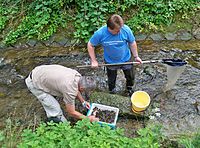
Photo from wikipedia
Now comes the latest celebratory, edited volume about a foundational chimpanzee field site, following in the footsteps of efforts from Mahale (Nakamura et al. 2015) and Bossou (Matsuzawa et al.… Click to show full abstract
Now comes the latest celebratory, edited volume about a foundational chimpanzee field site, following in the footsteps of efforts from Mahale (Nakamura et al. 2015) and Bossou (Matsuzawa et al. 2011). Other sites have chosen single-authored, synthetic books (Reynolds 2005), but somehow, Gombe’s update is the longest overdue, as its longevity as the senior ongoing field site now spans six decades (cf. Goodall 1986). The book’s content reflects a collective effort from Taï consisting of 28 chapters by a total of 41 authors. Two-thirds of these chapters concern ethological topics or their application, such as adoption, culture, demography, diet, gesture, hunting, immigration, play, rank, social networks, spatial and temporal cognition, tool use, and vocalization. The other third are unusual, even novel, for such a volume and reflect a wide range of research topics: data collection and statistical analytic methods, genetics, energetics, endocrinology (such as oxytocin), infectious diseases, and even gut micro-organisms. Two chapters are devoted to conservation. As for the format of the chapters, about half are broad, synthetic summaries of accumulated research, while the other half are specific, quantitative examples of recent research, so they are basically indicative journal articles. Conveniently, each chapter has its own reference list, but few cross-reference other chapters. Engagingly, most chapters begin with a thumbnail photograph and an anecdote about the topic, typically an incident involving a researcher and chimpanzees. About half the chapters end with a ‘personal insight box’, mostly from early career researchers. The book has abundant figures and tables and 71 monochrome photographs, with the only color photo being the cover. So, what makes Taï stand out from the other long-term (i.e., multiple decades of research) sites studying Pan troglodytes? Some accomplishments are unquestionable, such as having habituated five groups of chimpanzees for detailed observation (good) and having subjects who have suffered the widest range of anthropogenic diseases of any field site (not so good). The former has allowed inter-group comparisons of behavioral variation within a population, while no other research site has done more than pairs. The latter has spawned the most comprehensive and stringent set of hygienic practices of any chimpanzee field site. Other findings are intriguing if not unique: Is Taï the only long-term site in which ungulate prey are never hunted? Other chimpanzees take bovids and suids, but the renowned Taï ape hunters do not. After monkeys, their second choice of prey is tree hyrax, despite the abundance of duikers (Cephalophinae) available. Why? Many chapters show the payoffs of decades of sustained effort. The chimpanzees eat 503 types of plant food (leaf, fruit, seed, flower, pith, stem, bark, resin, wood, but no tuber), from 263 species. Demographic analysis shows overall long-term decline, including one group’s extinction, but encouraging stability in recent years; there are notable intergroup differences. Favored topics, such as hunting and nutcracking, have been studied intensively at Taï, tackled from a wide variety of analytic approaches. Hugely impressive identification and monitoring of thousands of fruit-bearing trees have enabled the first real field studies of foraging cognition, both spatial and temporal. * William C. McGrew [email protected]
Journal Title: Primates
Year Published: 2020
Link to full text (if available)
Share on Social Media: Sign Up to like & get
recommendations!